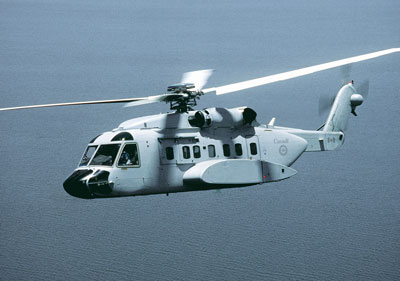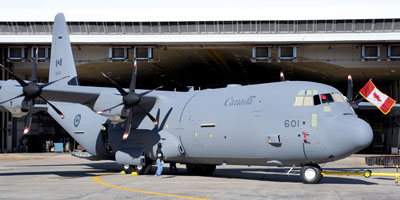 This information has been archived for reference or research purposes.
This information has been archived for reference or research purposes.
Archived Content
Information identified as archived on the Web is for reference, research or recordkeeping purposes. It has not been altered or updated after the date of archiving. Web pages that are archived on the Web are not subject to the Government of Canada Web Standards. As per the Communications Policy of the Government of Canada, you can request alternate formats on the "Contact Us" page.
Commentary

Image copyright Sikorsky Aircraft Corporation. All rights reserved.
Canada’s new Sikorsky CH-148 Cyclone helicopter.
Air Force Futures
by Martin Shadwick
For more information on accessing this file, please visit our help page.
Stood up in October 2005 as the designated “engine of Air Force transformation,” the Canadian Forces Aerospace Warfare Centre (CFAWC) is the “centre of excellence for aerospace power development in Canada, focusing on futurecasting, concept development and experimentation, doctrine development, Air Force research and lessons learned.” The CFAWC has, concomitantly, become an increasingly prolific publisher. Of particular note is its thought-provoking Projecting Power: Trends Shaping Canada’s Air Force in the Year 2019. Aimed at “key stakeholders in Air Force capability development,” the April 2009 study focuses on the “…trends, drivers and potential strategic shocks that could potentially seriously influence Canada’s Air Force a decade from today” and the “…expected impact of those trends on each line of operation currently identified [in] the AFCP [Air Force Campaign Plan].” Its authors caution that the study “…is not meant to be all-inclusive and should not be considered as a critical evaluation of the entire AFCP, but rather a starting point for further discussion and debate in certain areas.”
‘Futurecasting’ exercises of this type have long been a staple in government, industry, and academic circles. Many possess genuine merit, but futurecasting exercises also have fed a certain cynicism that they are often little more than self-serving advocacy documents, whose ultimate raison d’etre is to protect the special interests and future budgets of bureaucracies and other groups and actors. Projecting Power is an advocacy document in the sense that its authors are clearly not about to recommend the dissolution of Canada’s air force, but this does not mean that the study is thereby less useful, or that it constitutes ‘pain-free’ reading for the air force. The study’s speculation that the CF-18 replacement will likely be the “last manned fighter aircraft that Canada will ever purchase,” its observation that advanced simulation technologies will dramatically reduce the number of training aircraft, and its rather downbeat assessment of the prospects for manned ISR (intelligence, surveillance, and reconnaissance) aircraft are cases in point.
Part One of the study explores an eclectic range of “trends and drivers,” including demographics (and potentially serious consequences for the Canadian Forces), economic trends (also with potentially profound implications for the Canadian Forces), environmental trends (and their consequences for the Arctic), and energy trends (including ominous ramifications for the air force in terms of the cost of aviation fuel). Also considered are geopolitical trends with implications for the Canadian Forces – both domestically and overseas “…in operations across the entire spectrum of conflict within the arc of instability,” science and technology trends (i.e., simulation technologies, UAVs, space operations), military and security trends (including the proliferation of anti-aircraft weapons), and trends in asymmetric threats. The report asserts that the air force is “…clearly [positioned] to be the natural lead in aerospace operations and security for the Government of Canada.”
An intriguing, albeit, in some cases, well ‘outside the box’ feature of Part One is a series of “alternative outcome” scenarios. In one, set in 2016, a future coalition government concludes that serious personnel shortages in the Canadian Forces, and the perceived need to “…instill a loyalty and commitment to Canada’s goals among new Canadians,” justify the introduction of “mandatory or cooperative military service.” The coalition is defeated in Parliament, thereby “…leaving the CF with little choice but to resign itself to becoming a weak constabulary security force.” In another, set in 2012, a struggling economy, skyrocketing health care costs, and public desire for a post-Afghanistan peace dividend and reduced defence spending raise doubts about public willingness, and Ottawa’s ability, to provide sufficient resources for the current Air Force Campaign Plan. In other scenarios, successive American governments link continued Canadian free access to US markets to Canada’s continuing presence – in various forms—in Afghanistan, a future war between India and Pakistan generates “large scale skirmishes” in British Columbia and Ontario “where large populations from India and Pakistan have previously settled,” and a serious terrorist attack in Montreal produces large-scale civilian casualties. As a result, “French Canadians are united in calling for the government to immediately withdraw [Canadian] troops from western Pakistan. The coalition Government is defeated.” The scenarios involving US pressure with respect to Afghanistan, and a perceived public desire for a post-Afghanistan peace dividend, could help to inform a shorter-term debate regarding a Canadian role in Afghanistan post-2011. The current Canadian role cannot continue post-2011, but an air-oriented contribution built around fixed-wing airlift, rotary-wing operations (although heavy maintenance on the CH-147D poses challenges), and ISR (i.e., UAVs, CP-140s and, potentially, new acquisitions—Hawker Beechcraft MC-12Ws, anyone?) could be worth considering.
The second part of the study examines the expected impact of the perceived “trends and drivers” to each line of operation in the 2007 Air Force Campaign Plan. It notes that the CF-18, CP-140 and fixed-wing SAR fleets (i.e., CC-115 and CC-130), “…will have reached their end of life expectancy” by 2017 and posits that “sufficient funds may not be available to replace all fleets in a timely fashion,” given the “current economic climate and fiscal pressures placed on the [Government of Canada].” In that event, aircraft life extension programs “will have to be developed and implemented in a timely fashion.” The study notes that Canada’s aerospace industry is “an international leader in the field of supporting older airframes,” but cautions “…[that] the political pressures to retain Canadian aerospace jobs will be greatly challenged by the need to procure new foreign aircraft, which require less support from the Canadian aerospace sector.” As previously noted, Projecting Power concludes that the CF-18’s successor will likely be the last manned fighter aircraft acquired by Canada – echoes of Duncan Sandys, who infamously pontificated, many generations too early, on the diminishing prospects for manned fighters in the British Defence White Paper of 1957. “In the future,” notes the CFAWC study, “smaller, cheaper and expendable unmanned combat aerial vehicles (UCAVs) will have unsurpassable advantages over manned platforms in both performance and costs.” In a somewhat similar vein, “…by 2019, it is envisioned that the persistent capabilities of UAVs and satellites will have displaced the requirement for manned aircraft in the search portion of a SAR mission.” Moreover, “…the cost of a persistent ISR capability provided solely by manned aircraft is likely to be prohibitive. By 2019, surveillance satellites, UAVs and other persistent, semi-autonomous sensors will be highly matured and will likely offer significant cost savings.”
In the north, suggests the study, “…greater Arctic economic activities (including commercial shipping and aircraft transit) will translate in a greater demand for surveillance and monitoring, border patrol, law enforcement, disaster response and domestic SAR missions… The Air Force will need to develop a more agile and robust response (especially in the SAR domain) to these unavoidable challenges that may occur as a result of climate changes. A permanent SAR capability may even become a future requirement.” In 2019, the “method of delivering” the increased Arctic ISR capability “will be determined by factors such as: desired resolution, amount of persistent surveillance and cost. Ongoing programs such as Polar Epsilon II, Canadian Multi-mission Aircraft (CMA) and Joint UAV Surveillance and Target Acquisition System (JUSTAS) will provide options for this increasing requirement.”
Overseas, in the arc of instability, the air force “…will likely be required for humanitarian and/or stabilization missions,” thereby placing “heavy reliance on air mobility (strategic and tactical lift) as well as air-to-air refueling [AAR] assets.” The study does not explicitly elaborate on future requirements for AAR but, given its broader comments on combat search and rescue (CSAR) and air force support to the army, the ability to provide AAR for rotary-wing aircraft would appear logical. The study notes, for example, that the Directorate of Land Concepts and Designs (DLCD) “…projects that the regular army in 2019 is expected to operate more like today’s SOF [Special Operations Forces]. Many of these operations will require an insertion and extraction capability for small sections of soldiers in high density and urban areas within the arc of instability. The ARUH [Armed Reconnaissance Utility Helicopter] program [i.e., the putative successor to the CH-146], with planned deliveries in 2018-2022, should fill this current gap. With more activities expected to occur within the arc of instability, the Air Force should position its capital replacement programmes and resources to accommodate a CSAR capability.”
The report also draws attention to the requirement for extensive defensive air suites (DAS) to protect both manned and unmanned aircraft operating in high-threat areas, the need for extremely precise application of force (“collateral damage will not be tolerated, and the judicious application of precision effects will not only be demanded, it will be expected”), the requirement for “robust airfield defence” at overseas locations (intriguingly, the report posits that “the challenge for Air Force operations will be to determine who will man the airfield defence teams outside the fence”), the need for a substantial air force role in space control, and the continuing relevance of an air demonstration capability (i.e. “air demonstration must be promoted as a highly visible national symbol that does much to unite our regionally and culturally diverse population.”)
The net result is an intriguing document. That said, and while acknowledging that the 45-page report was not intended to be all-inclusive, one would have welcomed further analysis and specificity in some instances. The CF-18’s would-be successor, for example, is referenced on multiple occasions, but there are few insights into its future employment. Similarly, air force support to the army is explored in reasonable detail, but air force support to the navy is essentially left unexplored. The report advances solid rationales for an expanded air force capability in the Arctic, but is, arguably, insufficiently sensitive to the urgency of the task. The creation of an Arctic-based composite squadron with airlift, ISR, and SAR capabilities should be pursued now, and with vigour. The report is correct when it observes “…[that] it will become necessary to influence the national public will in order to secure appropriate funding for future force development, including ongoing and new capital [programs]. It is forecasted that, with an ageing population, dedicated funding for the Air Force will be challenged as the Government of Canada is faced with the need to balance national security and national welfare.” In the early decades of the Cold War, the air force enjoyed conspicuous success in advancing its case, but the ‘magic’ disappeared in the post-Cold War era. This, in part, reflected developments beyond the air force’s control, but there have been more than a few ‘self-inflicted wounds.’ If Canadians and their leaders are to be convinced of the need for a credible multi-purpose air force, innovative strategies will be required to provide them with a clear, cogent, and compelling rationale.

Lockheed Martin Aeronautics
Canada’s first CC-130J Hercules rolls out of Lockheed Martin’s factory paint shop, 14 January 2010.
![]()
Martin Shadwick teaches Canadian defence policy at York University. He is a former editor of Canadian Defence Quarterly.






